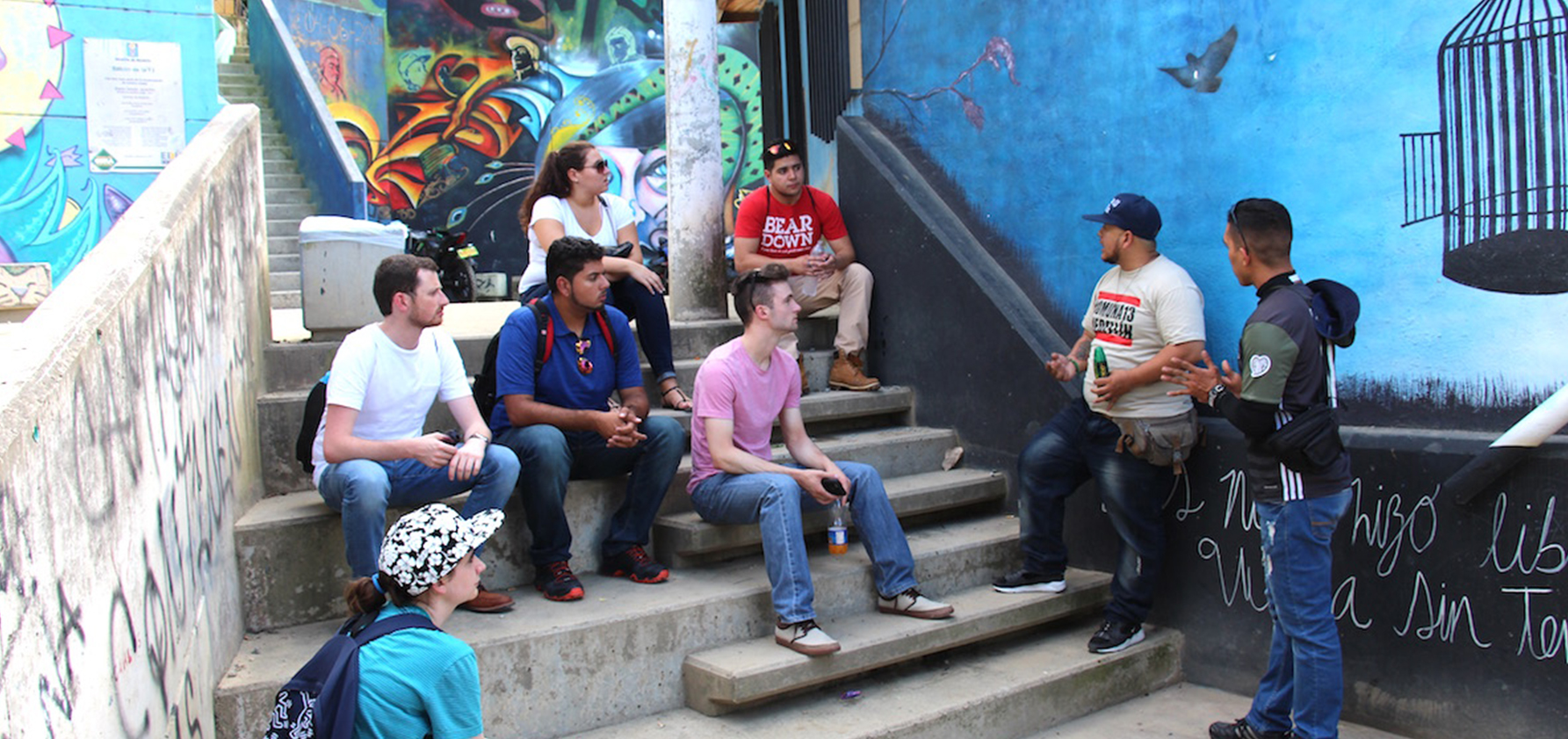
Where would you expect to find the most breathtaking collection of street art in the world? Where would you find walls, streets, and stairs exploding in a vibrant array of colors representing the rich cultural history of a neighborhood? The answer might not be what you expect: The neighborhood is in Medellín, Colombia and is called “Comuna 13.” During the height of the drug wars in the 80’s and 90’s, Comuna 13 was the most notorious neighborhood in Medellín, which was the most dangerous city in the world at the time. So how in the world did our study abroad group from Moravian College end up here?
The objective of our time abroad this May term in Colombia is to understand important global issues from multiple perspectives, using Colombia as a case study. We’re looking at inequality, conflict, diversity, poverty, and human rights to name a few. Colombia has a reputation around the world, especially in the United States, as a violent narco-state, and kidnappings and cocaine are the first words that come to mind. We sought to break these biases by seeing firsthand how this beautiful country is peacefully transitioning away from its violent past into a rich cultural center. Comuna 13 was the ideal mechanism to achieve this. In a city where the history of the violence is vivid in people’s minds and where the architecture and buildings themselves have been destroyed and forgotten, Comuna 13 is a unique juxtaposition of remembering the past and moving on to the future.
We started our journey in the hills of western Medellín by meeting Ciro, a Colombian rapper, tour guide, and neighborhood activist who uses hip hop to promote community involvement. As Ciro led us around the mountainous, labyrinthian landscape of the neighborhood, he told us tear-jerking stories of the violence and desperation that consumed the lives of its residents. The drug cartels, paramilitary groups, and even the Colombian government were responsible for horrendous crimes against the people living there as all battled for control of the territory. Although the violence is certainly a dark chapter in this community’s past, the graffiti murals, created by artists from around the world, tell a history that simply cannot be learned in a classroom.
The violence of the neighborhood was exacerbated by the social disconnect experienced by its inhabitants. Comuna 13 is situated high up on the side of the mountain that forms the western border of the city. With no public transportation reaching the community, social inequality and lawlessness grew. In 2008, the city installed cable cars to connect Comuna 13 to the main part of the city below. But it wasn’t enough. So this city, known for its innovation, found a solution to further bridge the community in a profoundly simple way: outdoor escalators. Divided into six main sections, the escalators run up the neighborhood a distance of 1,260 feet, making the journey from bottom to top six minutes when it had previously taken thirty-five. The escalators begin where public transportation ends and previously residents trudged up the equivalent of 28 flights of stairs. Part of our trip thus far has focused on how fragmented communities are susceptible to loss of cultural identity, violence, and corruption. By bringing the people of Comuna 13 together via escalators and connecting them to the city center via cable cars, more economic activity is possible and therefore more investment back into the community is possible. A great example of this sort of investment is seen in the cultural house for the organization Ciro works for: Casa Kalacho (Kalacho House).
The house provides free graffiti, breakdancing, and rap lessons so that through the sharing of artistic ability, members of the community can generate income for themselves by selling their works to the bigger cities. As part of the experience we were given the opportunity to leave our mark using spray paint on a canvas outside of the house.

Comuna 13 uses graffiti to memorialize its past while progressing forward and away from the violence. Throughout the neighborhood a variety of murals, created from artists all around the world, help to represent stories of people and events that have happened in Comuna 13. A neighborhood that experienced some horrific acts of violence has chosen to remember the tragic events that they experienced, instead of choosing to forget them. They have adopted this into their community’s culture, and have chosen to progress into the future holding onto the memories through beautiful murals of graffiti.
One mural illustrates elephants as the animal represents strength, wisdom, and the power of remembrance. Murals of people are also very common. These murals don’t always represent a specific person, but often a group of people. There were murals to represent motherland, for example, which was depicted through a woman with an unborn child hidden within the picture. This pays homage and appreciation to the land and the people. The mural of the elephants showed them waving white flags. During the siege of 2012 (Operation Mariscal) when the military sent in 700 troops to rid the area of violence, some 39 community members lost their lives.
One brave grandmother left her house with a white sheet yelling “basta!” (enough). More members of Comuna 13 then began to wave or hang white flags, handkerchiefs, t-shirts, etc., showing their resistance to the violence and above all else their desire for peace.
At the end of our time in Comuna 13, Ciro left us with the words: “From this day on, you all are members of Comuna 13. We hope that as new members of our community, you’ll carry with you the message of peace and non-violence and help spread the word of our work here.” This is our message.